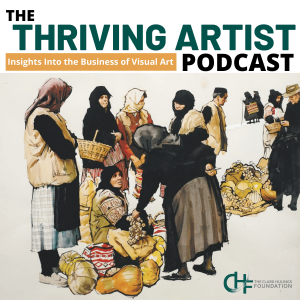
Dean Mitchell is a nationally recognized painter of figures, landscapes, and still lifes, and his work often depicts themes from his southern upbringing. He’s won top honors from the National Watercolor Society and American Watercolor Society. Among the museums that house his work are the Nelson-Atkins Museum of Art in Kansas City and the St. Louis Art Museum. Dean is also a member of CHF’s advisory board.
Building A Reputation:- “I had to figure out a platform in which I could get known. The competitions started early on and that’s how I started nationally and internationally.”
- “Shows were the best way I knew to level the playing field. I did try to get grants, but that didn’t work out for me. Competitions worked out for me.”
- “Galleries have other artists they’re representing. And so I’d look around and think ‘how am I going to separate myself from the pack?’ So I’ve always looked at ways to market myself.”
- “Galleries are interested in selling the work. I was interested in getting known and [wanted] to be part of a conversation nationally.”
- “I’ve been in small towns and people think ‘there’s no art market there,’ but some of those people who live in those small towns are friends with people who are in the museum world.”
- “Galleries are a piece of the puzzle, but they are not the complete puzzle.”
- “When I did my first book, galleries told me ‘don’t do that, it’s a bad deal.’ And after my book, one of the galleries that said that, it’s sales tripled. That told me right there marketing was a huge part of it.”
On Entering Competitions:
- “I don’t think I could ever get too well known that I wouldn’t want to do them. Why should I quit the very thing that gave me the platform for the voice I have?”
- “Shows were the best way I knew to get my name out there because they also did catalogues, and those catalogues became a marketing tool for my work.”
- “I thought the best way to build my platform was put my work in front of my peers, particularly in shows where they were giving out prize money. Sometimes when a painting wins a prize, a collector will suddenly be interested in it.”
- “You have to be your own critic. Sometimes the painting that’s edgy, collectors don’t necessarily want; but curators and museum directors who are judging shows like [it]. That’s something I think artists have to recognize.”
- “In order to get attention, I have to merit attention. I can’t just say ‘oh, I’m a great artist.’”
Branding:
- “I’ve had galleries say to me ‘oh, we can’t sell that’. But the paintings they said they couldn’t sell, ended up selling for $40,000 each. So I will not have someone tell me what to paint.”
- “I’m controlling this narrative; no one else can control it. How someone wants to perceive it? That’s up to them. I have nothing to do with that.”
- “The brand isn’t consciously created. I’ve always, as an artist, explored my own emotions.”
- “I’m no Salvador Dalí, but I have built enough of a market that now I can start to work on leaving a legacy.”
Genre and Style Pressure:
- “I looked at watercolors and thought ‘people are not willing to pay as much for these. This could possibly be another competition entry that’s a little less expensive.’”
- “I recognized there were a lot of watercolor competitions. And these built my platform. They built my reputation. But when people come to my show, they see how many mediums I work in.”
- “People think ‘I can’t afford that oil, but I can afford this watercolor.’ And people started to snap them up.”
- “There are people who are championing different things. Their sensibility might be different from yours. I do think realism has taken a hit, but I do think artists can be creative with it.”
More Episodes
Virtual & Analog Art—Daniel DiGriz
 2021-11-26
2021-11-26
 2021-11-26
2021-11-26
Virtualize Your Art Career: Part 2
 2020-10-14
2020-10-14
 2020-10-14
2020-10-14
Virtualize Your Art Career: Part 1
 2020-09-30
2020-09-30
 2020-09-30
2020-09-30
Artists Are Solving Atomic-Level Problems
 2019-07-12
2019-07-12
 2019-07-12
2019-07-12
Fearlessly Take On The Big Daddy Ugly Goal
 2019-05-29
2019-05-29
 2019-05-29
2019-05-29
Lock Down Your Rights to Your Own Art
 2019-02-18
2019-02-18
 2019-02-18
2019-02-18
Make the Gig Economy Work for You
 2019-01-23
2019-01-23
 2019-01-23
2019-01-23
Get to Emerging Artist Status and Beyond
 2019-01-12
2019-01-12
 2019-01-12
2019-01-12
012345678910111213141516171819
Create your
podcast in
minutes
- Full-featured podcast site
- Unlimited storage and bandwidth
- Comprehensive podcast stats
- Distribute to Apple Podcasts, Spotify, and more
- Make money with your podcast
It is Free
- Privacy Policy
- Cookie Policy
- Terms of Use
- Consent Preferences
- Copyright © 2015-2024 Podbean.com





